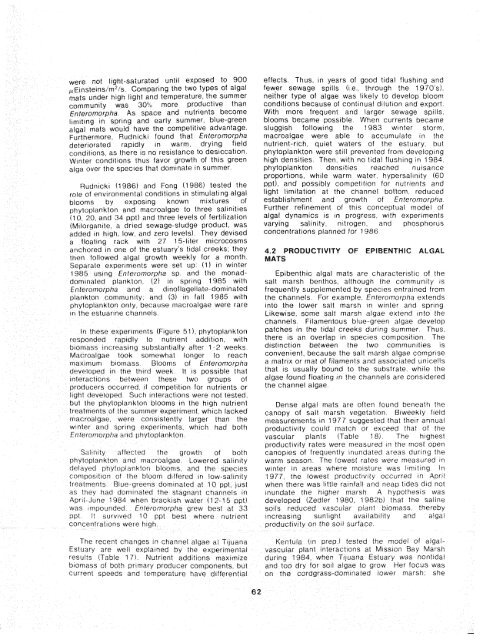The Ecology of Tijuana Estuary, California: An Estuarine Profile
The Ecology of Tijuana Estuary, California: An Estuarine Profile
The Ecology of Tijuana Estuary, California: An Estuarine Profile
Create successful ePaper yourself
Turn your PDF publications into a flip-book with our unique Google optimized e-Paper software.
were no? irght-saturated untri exposed to 900<br />
N.,Etnste~nslm"~ Gompar~ng the two types <strong>of</strong> algai<br />
mats under high lgght and temperature, the summer<br />
cammunrty was 30"0 more productrve than<br />
Enl~romorpha As space and nutrients become<br />
Iimiting in spring and early summer, blue-green<br />
algal mats would have the competrtrve advantage<br />
Furthermore. Rudnicki found that Errteromorpha<br />
deterlorated rapidly in warm, drying field<br />
condrtions, as there 1s no resrslance to desrccatron<br />
W~riPer conditions thus favor growth <strong>of</strong> this green<br />
alga over the species that donrrnate in summer<br />
Wudn~cki (1986) and Fong (1986) tested the<br />
role <strong>of</strong> environmental conditions in strmulating algal<br />
blooms by exposing known mlxtures <strong>of</strong><br />
phylo[~Z~nklon and macroalgae to three salrntties<br />
(10, 20, and 34 ppt) and three levels <strong>of</strong> fertlilzatlon<br />
(Mllorganite, ir dried sewage-sludge product, was<br />
added ln hrgh, low, and zero levels) <strong>The</strong>y devrsed<br />
a fioallng rack wrth 27 15-lrter rnierocosms<br />
tnrlclzored rn one <strong>of</strong> the estuary's tldal creeks, they<br />
then tollowed iffgal growth weekly for a month<br />
Separcrlc experirrlents waro set up (1 in wrnfer<br />
1985 uslng Enteromurplla sp and the monaddwm$r~;ated<br />
plankton, (21 in sprrrig 1985 wlth<br />
Prrtcrc~rnorpha and a clin<strong>of</strong>lagellate-dom~nated<br />
plsrrlkton community, and (3) In fall 1985 wrth<br />
tihytoplanktori only because niacroalyae were rare<br />
in the ~str~sr rrtl? channels<br />
It, thasc experiments (Figure 5 11, phytoplankton<br />
foapnntdcd rnptdly lo nitlrrerit addrlron, with<br />
blQmits3 Irlcrees#rrg suhstantrally dftcr 1-2 weeks<br />
Mar:traalgae took somt:wtiat longer lo reach<br />
fllaxrrmiirn btorriass $looms <strong>of</strong> Entcromorpha<br />
tlc?vc~loped rn the thirrf week It is poss~ble that<br />
interaclians t>etwo~?n thest? two groups <strong>of</strong><br />
pr.crcluccbrc, C3cckirrQd rf eompet~tron for nutrients or<br />
lryf~t rlevelopcd Such ~nteract~ons were not tested,<br />
but the phytoplankton blooms in the htgh nutrient<br />
trtratmf:nls <strong>of</strong> tho sunmar expertmont which la~ked<br />
macroalgae, were consistently !arger than the<br />
winter arttJ svnrsg c?xperrmonts, whrcl? had both<br />
Ef~If~r~)t~?t~rpl!d ~rtld 1llryto~larlkf0(1<br />
SIilrt~rty ,lffs?~ltld tiw growttl <strong>of</strong> both<br />
frhylnj?lanktcrrt arid nracroalgae lowered saiinity<br />
dclttycd ph ytr,giiankton blooms, and the specres<br />
conrh?osrliuit <strong>of</strong> !he bluorrl dilferr>d in low-saltnrty<br />
trctritrnents Blue-greens donr~r.ialed at 16 ppt. just<br />
ar, lhev had dornrnatcd the strrgtlani chanfruts In<br />
Apr~i- June 1984 when brackish wiitcr (1 2- 15 ppt)<br />
was impounded E<strong>of</strong>crom<strong>of</strong>pha grew best at 33<br />
opt I! surv~ved 10 rs~t best where nutrient<br />
effects Thus. In years <strong>of</strong> good tidal flushing and<br />
fewer sewage sprlis !I e , through the 1970's)<br />
nerther type <strong>of</strong> algae was likely to develop bloom<br />
cond~taons because <strong>of</strong> continual diiut~on and export<br />
With more frequent and larger sewage sp~iis<br />
blooms became poss~ble When currents became<br />
sluggish Iollow~ng the 1983 winter storm<br />
macroalgae were able to accumulate rn the<br />
nutrrent-rich, quiet waters <strong>of</strong> the estuary but<br />
phytoplankton were st~ll prevented frorn deveio~~ng<br />
hlgh densitres <strong>The</strong>n, wlth no trdal flushing In 1984<br />
phytoplankton densities reached nuisance<br />
proportions, wh~le warm water hypersal~nrty (60<br />
pptl, and possibly competftion for nutrients and<br />
l~ght lrmitatron at the channel bottom reduced<br />
establ~shment and growth <strong>of</strong> Enteromorpha<br />
Further refinement <strong>of</strong> this conceptual model <strong>of</strong><br />
algai dynamics is cn progress wrth experiments<br />
varying salln~ty, nitrogen, and phosphorus<br />
concentratrons planned for 1986<br />
4.2 PRQDUCflVilTY QF EPlBENTHlC ALGAL<br />
MATS<br />
Epibenthrc algal mats are characterist~c <strong>of</strong> the<br />
salt marsh benthos, although the community 1s<br />
frequently supplemcntcd by specles entrained from<br />
the channels For example Enteroinorpl>a extends<br />
into the lower salt marsh 9n winter and spring<br />
Likewrse, some salt rriarsh dlgde extend into the<br />
channels Ftlarnentous blue green algae develop<br />
patches rn the tidal creeks cfurfr~g summer Thus<br />
there is an overlap in species composition <strong>The</strong><br />
dtstinctcon between the two comrni~n~t~es 1s<br />
convenrent, because the salt marsh algae cornprfse<br />
a matrtx or tnat <strong>of</strong> ftlaments and assoc!atpcl unlcells<br />
that 1s usually bound to the substrate while the<br />
algae found fioaling in the channels are considered<br />
the channel algae<br />
Dense algal mats are <strong>of</strong>ten found beneath the<br />
canopy <strong>of</strong> salt marsh vegetat~nrr Biweekly freld<br />
measurements rn 1977 suggested that therr annual<br />
productivrly could match ar exceed that <strong>of</strong> the<br />
vasculvr piants (Table 1 Bj <strong>The</strong> highest<br />
productivity rates were rneasured in the rnosl open<br />
canopres <strong>of</strong> treql~enlly inundated arcas during the<br />
warm season <strong>The</strong> lowest rates badore measured In<br />
winter rr; areas where no~stirrc was l~rn~ting In<br />
1977. the lowest prad(rctrvity occurred tn Aprrl<br />
when there was little rarnfall and neap tides did not<br />
inundate tile higher marsh A hypothesrs was<br />
developed (Zedler 1980, 1982b1 that tne saline<br />
so$ls reduced vascitiar plant biomass thereby<br />
Increasing suniighi avatiabrf~ty and aigal<br />
producttv~ty on the sat! sirrface<br />
<strong>The</strong> recent changes !n chanrrel asgas at Ttjuana KenZuia iin prep 1 tested the modet <strong>of</strong> aigal-<br />
Este:ary arc wcli expiatned by the experimental vascuiar pfant interactior4s at Mtssion Bay Marsn<br />
rcsuils (Table 17) Nutrient eddiliuns rnaxlmrze during T984, whc~ <strong>Tijuana</strong> Eslhiary was nont~dal<br />
biomass <strong>of</strong> both pnmary producer components, but anb Zoo dry far so11 algae to grow Her focus was<br />
cuiren: speeds and temperature have differentia! on the cordgrass-dominated lower marsh, she

















